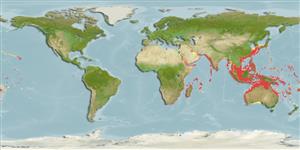Common names from other countries
>
Elopiformes (Tarpons and tenpounders) >
Elopidae (Tenpounders)
Etymology: Elops: Greek, ellops = a kind of serpent (Ref. 45335).
Environment: milieu / climate zone / depth range / distribution range
Ekologi
marina; brackvatten; havsvandrande. Tropical; 38°N - 37°S, 22°E - 153°W
Indo-Pacific: Mossel Bay in South Africa, to the Red Sea and India, possibly to western Pacific (Ref. 3968).
Size / Vikt / Age
Maturity: Lm ? range ? - ? cm
Max length : 118 cm FL hane/ej könsbestämd; (Ref. 40637); common length : 50.0 cm SL hane/ej könsbestämd; (Ref. 4967); publicerad maxvikt: 10.8 kg (Ref. 40637)
Short description
Bestämningsnycklar | Morfologi | Morfometri
Taggstrålar i ryggfenan (totalt) : 0; Mjukstrålar i ryggfenan (totalt) : 20 - 27; Taggstrålar i analfenan: 0; Mjukstrålar i analfenan: 14 - 18.
Occurs in coastal waters, but enters lagoons and estuaries (Ref. 4832) [actual freshwater records remain to be confirmed]. Benthopelagic (Ref. 58302). Young and adults feed on small fishes and crustaceans (Ref. 5213). Probably spawn at sea, but the transparent larvae migrate to inshore areas and are often found in brackish water (Ref. 7050). Are voracious carnivores that take fish, squid and shrimp bait (Ref. 3968). Edible, but not tasty and full of bones (Ref. 3968). A total length of 126 cm for this species has been reported from Knysna, South Africa (G. Bernardt, pers. comm., e-mail: gerard@smallstreams.com) .
Life cycle and mating behavior
Maturities | Reproduktion | Spawnings | Egg(s) | Fecundities | Larver
Smith, M.M., 1986. Elopidae. p. 155-156. In M.M. Smith and P.C. Heemstra (eds.) Smiths' sea fishes. Springer-Verlag, Berlin. (Ref. 3968)
IUCN Red List Status (Ref. 130435)
CITES (Ref. 128078)
Not Evaluated
Threat to humans
Harmless
Human uses
Fiskeri: kommersiell; sportfisk: ja
Verktyg
Special reports
Download XML
Internet-källor
Estimates based on models
Preferred temperature (Ref.
115969): 20.7 - 28.4, mean 26.9 (based on 1366 cells).
Phylogenetic diversity index (Ref.
82804): PD
50 = 0.5176 [Uniqueness, from 0.5 = low to 2.0 = high].
Bayesian length-weight: a=0.00676 (0.00514 - 0.00889), b=2.99 (2.91 - 3.07), in cm Total Length, based on LWR estimates for this species (Ref.
93245).
Trofisk nivå (Ref.
69278): 4.0 ±0.3 se; based on diet studies.
Fishing Vulnerability (Ref.
59153): Very high vulnerability (79 of 100).
